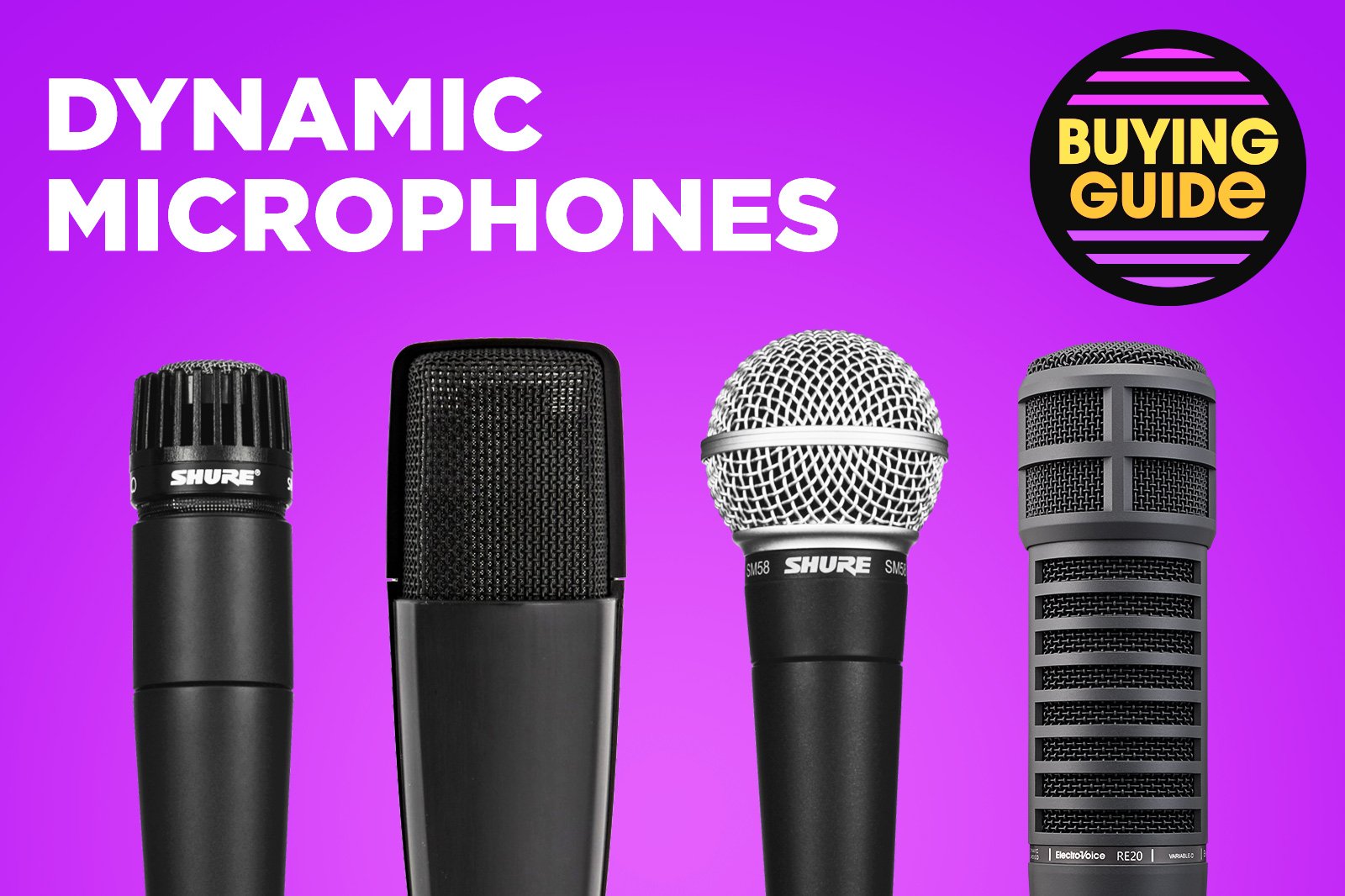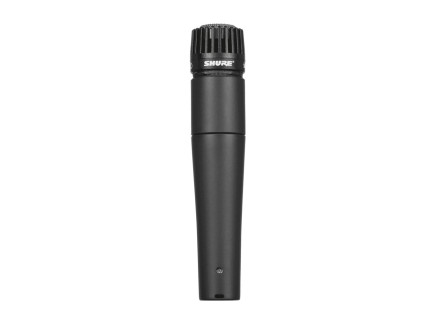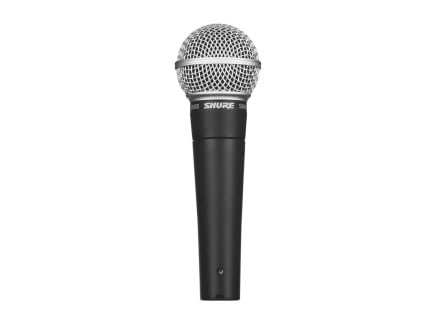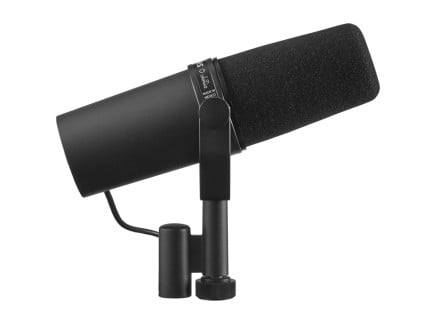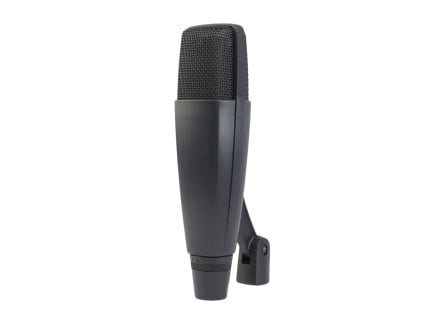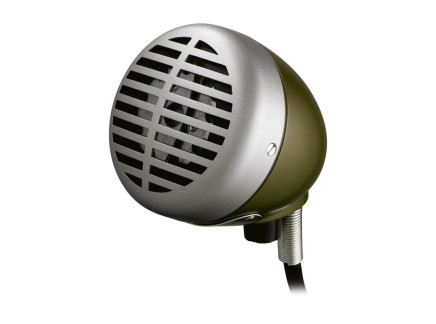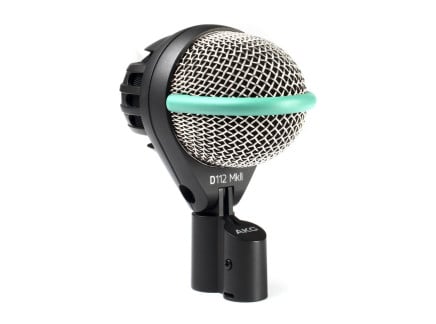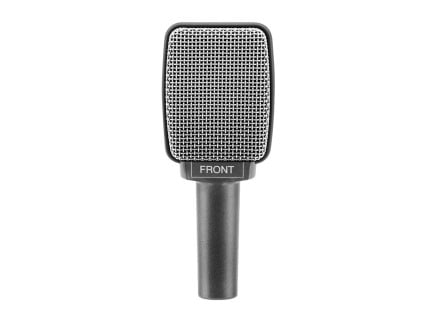Microphones: they're the gateway through which acoustic sound can be captured in a recording. If you're embarking on building your first home recording studio or performing setup, odds are that you'll need to take a look at picking up a microphone or two. Because of the sheer number of microphone options out there, though, that can be a daunting task—what's the difference, after all, between a dynamic and condenser microphone? What's the difference between a cardioid and omnidirectional polar pattern?
We've endeavored to answer some of these questions in our articles about microphone types and microphone polar patterns; but here, we'd like to take some space to recommend options specifically for dynamic microphones.
Dynamic microphones are tremendously versatile, and have a lot to offer almost any musician or recording engineer. When compared to condenser microphones, dynamic mics have generally lower sensitivity—which gives them the ability to reject unwanted environmental sound, reduce risk of feedback, and to handle particularly loud sounds. As such, dynamic mics are commonly used in vocal performance, and for miking guitar cabinets, drum kits, low brass, and much more...in fact, many dynamic mics are equally well-suited to a number of different applications. Odds are, if you're looking to pick up your first mic for recording, this list will contain the right mic for you—so let's take a look at our favorite dynamic mics, period.
Shure Classics: SM57 + SM58
Fixtures in professional studios, band lockouts, and venues of all sizes, the Shure SM57 and SM58 are probably the most popular, widely-recognized microphone models both by name and image. The 58 with its silver ball grill and the 57 with its flat edge are beloved for their sound, durability, and affordable price point. Both microphones are based on the same cartridge—the Unidyne III—and have similar sounds, however, the placement of cartridge in relation to the grill is where the true difference lies, not to mention the actual grill itself. Depending on your application, you might find one more helpful than the other.
Let's first look at the SM58, which for decades has been the go-to live vocal mic for bands and venues due to its great sound and rugged durability. It's not uncommon to find a dented grill, paint half-chipped 58 in the back of a tour van or bottom of a miscellaneous audio container…and odds are that it still gets used and functions perfectly. With a casing that reduces handling noise and a grill designed to eliminate plosives and wind, vocalists are always delighted to hear a feedback-free, clear vocal track in the monitors.
It's not just good for vocals, though—the 58 can be used on just about anything you'd like, and has a fairly focused polar pattern that lets unwanted background noise stay, well, in the background. The frequency response features a slight bump around the 2k–5kHz range for clearer enunciation of the human voice. With its bulbous grill, the 58 has a slightly reduced proximity effect, but can still benefit from techniques that involve manipulating proximity for tonal effect.
Closely related but slightly different is the SM57. Llike the SM58, it is also a dynamic mic that works in all the same spaces, but often is used for slightly different applications due to its grill being connected to the cartridge. Eschewing the ball grill and pop filter, 57s have a diaphragm that is closer to the tip than a 58, making them perfect for more precise applications where plosives aren't an issue.
You will often find them on a horn, snare drum, or guitar amp because of this precision, but also because of its ability to withstand incredibly loud sounds. Crank the amp without worrying about getting unwanted distortion, or reproduce the true sound of a sax player's solo effortlessly. Grab a couple of 57s for stereo recording, whether it's musical or for sound design. You can also use it on vocals, and many do, because they have an inherently brighter sound due to a higher output above 5kHz. This is due to the diaphragm being able to get closer to the source—and this also makes for a richer low end.
So, that is a lot of things to consider…and if this is your first time dipping into the lagoon of microphones, let's make it simple: for vocals, get the SM58, and for instruments and amps, get the SM57.
A Vocalist's Dream: Shure SM7B
There are, however, many other mics out there and one that often gets compared to the SM57 and SM58 is their beefier, more expensive sibling, the Shure SM7B. This is because all three share the same Unidyne III cartridge, which is responsible for frequency lift after 2kHz. But the SM7B is still a prized microphone among broadcasters, vocalists, and recording engineers alike…so, what makes it so special compared to its more cost-effective siblings?
There are several differences. First off, you will notice a very robust windscreen that makes it perfect for any vocal application without having to use a pop filter. The SM7B is also more robust in silhouette, thanks to a large humbucking coil that reduces the risk of external interference, making this mic exceptionally quiet. A pair of switches on the back of the mic also activate an internal high pass filter and internal presence boost for added high end—a treat for vocalists looking to bring their voice to the forefront of a mix.
One of the key benefits of the SM7B is also the thing that many people take umbrage with: its low volume. You will need about 60dB of gain, which some audio interface preamps just cannot provide. Fortunately there are solutions like the Cloud MicrophonesCL-1 Cloudlifter and Soyuz The Launcher, both of which provide +25dB of clean boost for low-volume dynamic mics. Simply plug into a phantom power-equipped preamp and you'll be ready to get the best out of your SM7.
While the SM7B shares the same cartridge as the 57 and 58, it has a larger diaphragm, which makes it considerably more sensitive. The useful frequency response range is 50Hz–20kHz, which helps bring out some clearer, cleaner vocal takes for both singing and voiceover. You will find these mics everywhere and their impressive built-in windscreen makes them perfect for that creamy, public radio close-talking sound as well as for intimate vocal performances. In fact, the SM7 is famous for its use on classic records like Michael Jackson's Thriller; a sure vote of confidence in its usefulness for characterful, cutting, pristine vocals.
Being a dynamic mic, it can handle exceptionally loud sound sources, and it's not uncommon to find an SM7B on a guitar cab, but it can also be great for acoustic instruments, whether delicate or loud. If you do a little bit of searching, you will find that many people use this mic on just about everything because of its natural sounding tone and wide-ranging frequency response.
Classic sounds, neutral coloration, and a design that has been tested for decades, the SM7B has planted itself as an industry staple that's useful in myriad situations. We highly recommend this mic for anyone looking to record anything, especially the voice.
A Little Bit of Everything: Electro-Voice RE20
Though it has long been associated with broadcasting applications, the legendary Electro-Voice RE20 is another example of a dynamic microphone design with incredible versatility. It has an established presence on sets for film, TV, radio, and, more recently, podcasting, but it's also a staple of recording studio mic lockers both large and small. Perhaps unsurprisingly, this microphone's reputation for maintaining the full-bodied tone of a voice translates to guitar amps, kick drums, horns, and a number of other instruments, too, and that's a big reason why the RE20 has remained a favorite since it was released in 1969.
One of the highlights of the RE20 is its usage of Electro-Voice's Variable-D technology, which was developed in the years leading up to the release of the RE20. Most directional microphones are susceptible to experiencing the proximity effect, a phenomenon where low-end frequencies become more pronounced or even exaggerated when the mic is placed within a few inches of the source. But with its unique design, the RE20 is able to maintain its flat frequency response at further distances and less-than-ideal placements. Thus, if an announcer or vocalist were to slightly turn their head to the side while speaking into an RE20, the body of their voice would remain intact without thinning out.
Another benefit of the RE20's Variable-D design is the tight low-end that comes along with it. With a published frequency response reaching down to 45Hz, the RE20 moonlights from its broadcasting work as a popular kick drum and bass instrument microphone. Throw it inside a kick and use it for a solid jazz or funk sound, or use it as the bass-end component in a blend with other mics for a more modern sound. With a bass, whether it's an upright or electric, the RE20 can help to supply the foundational low-end to a mix—the flat response lends itself well to capturing low frequencies, without any boosts or curves to get in the way of any natural treble roll-off.
At the end of the day, the RE20 is another well-rounded dynamic microphone that's equally suited for voice work as well as capturing instruments. If you're primarily doing voice work or already own another microphone on this list and are seeking a different sonic flavor, it's hard to go wrong with the RE20. And while we're here, we should also shout out a couple of Electro-Voice's other RE20-variants: the more budget-inclined RE320, and the tricked-out, neodymium-equipped RE27N/D.
Studio Workhorse: Sennheiser MD 421 II
Sennheiser's MD 421 isn't new on the scene; in fact, in some form or another, it's been in production for over sixty years. Based on a design originally intended for electronic news gathering, this microphone is now ubiquitous in the worlds of broadcast, public address, and of course, studio recording. Frankly, we do believe that every studio should have at least one, if not several...but what makes this now decades-old mic so special?
The current-issue Sennheiser MD 421-II employs a highly-focused cardioid pattern in order to provide highly-effective isolation from environmental sound. Truly, its rejection of off-axis sound is one of its strongest suits—it's quite easy to use in even the rowdiest of live settings. Of course, this also aids significantly in feedback rejection.
When discussing microphone design, many make a point of saying that their mics are "rugged," to the point where this term has lost some of its meaning. However, it's difficult to talk about MD 421 without mentioning its build quality; it's built like an absolute brick. More so than nearly any mic we've encountered before, it is quite well-suited to the rigors of the road—in fact, we've literally seen vocalists kick it, throw it on the ground, and whip it through the air only to emerge entirely unscathed. Of course, we don't necessarily recommend kicking your microphone...but if you absolutely have to, you should probably choose an MD 421.
Naturally, the MD 421 isn't just for mic-kicking rock singers. It features an integrated five-position bass roll-off switch, which provides you multiple settings contoured for use with speech or musical applications. This simple passive EQ scheme makes it easy to tailor the 421 to nearly any source: it's used just as commonly for press conferences as it is for kick drums, upright bass, trombones and other brass instruments, toms, guitar cabs, and much more.
It's rock-solid. It sound clean and clear, and it has a ridiculous dynamic range. It has significant rejection of off-axis sounds, and maintains the color and character of whatever it's aimed at. It's great for use on basically any instrument you put it in front of (though it's particularly well-suited to loud sounds). As such, it's hard to think of a performer, recording engineer, or home studio owner who wouldn't benefit from having an MD 421 II. If you're looking to pick up your first microphone, or you're looking to add a flexible tool to your growing mic locker, it's a solid choice—frankly, it's hard for me to think about recording without one.
Special-Purpose Dynamic Microphones
So far, we've mostly talked about microphones that provide a lot of bang for your buck—mics that are equally well-suited to a broad range of recording tasks. If you're just starting out building a recording setup, we'd strongly recommend starting with whichever of those speaks to you and seems best-suited to your needs. But of course, there are other excellent mics out there that aren't quite so general-purpose. Let's take a look at a few dynamic mics with somewhat narrower intended use-cases that nonetheless sound excellent.
If you're looking for a mic specifically for a guitar cab, we'd recommend taking a look at the Sennheiser E 609. It uses a supercardioid polar pattern in order to produce a highly-focused pickup area designed to be used extremely close to the sound source. As such, it's quite common to see the E 609 hung directly over/onto the face of a guitar cabinet, held in place by its mic cable alone.
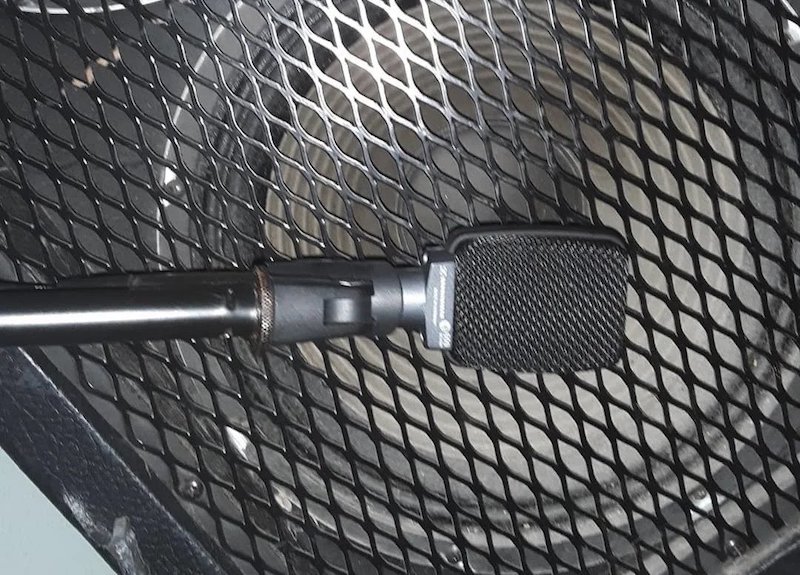
It uses an internal hum-compensating coil and a quite advanced, naturally shock-mounted design to eliminate risk of external electromagentic and mechanical interference. It's a clean, clear, robust, no-nonsense solution for miking guitar cabs; and while it also sounds great on low brass and winds, we expect that you'll find it has a permanent home draped over your amp of choice.
AKG's D112 MKII is a go-to choice for any scenario in which you need high SPL handling, punchy response, and thick, beefy response to low-end tones. It's most commonly used for kick drum and bass cabinets, though it's also at home close-miking low brass instruments. The D112's diaphragm has a super low resonant frequency, providing its low-end power, and a narrow-yet-notable presence boost around 4kHz helps to bring a bit of bite and clarity to whatever goes through it—a big help for instruments that otherwise might be covered up in the lower end of your mix. Its power, punch, and pleasantly contoured tonal response makes this mic a staple for both live sound reinforcement and studio recording scenarios.
Our final recommendation for today is a cult favorite—Shure's 520DX "Green Bullet" microphone. The Green Bullet was developed specifically for use as a microphone for the harmonica, and as such, it has a couple of unique and peculiar features. For one, it's specifically designed to be used in handheld situations, with internal shockmounting that effectively reduces handling noise. It also has a built-in volume control knob, and an integrated 1/4" cable for connecting to your PA or recording console.
Perhaps its most defining characteristic is its peculiar frequency response, ranging from ~100Hz to ~5kHz. This provides microphone a gritty, bluesy, lo-fi sound...but when applied to other instruments, it imparts a peculiar, distinct grit and charm. And that's where our primary interest in it lies: as a grungy vocal mic, a weird way of capturing guitars and bass, brass, or even a trashy snare drum sound. We wouldn't suggest the Green Bullet as the first microphone for your arsenal...but it's a characterful tool that provides a fascinating, grungy sound every time you need it.
Dynamic Microphones: Transducers You Can Trust
No doubt dynamic microphones are some of the most generally useful mics altogether. They can work well both in live sound and studio recording applications. They work great for capturing loud sound sources. They offer stellar isolation from their environment, making it easy to keep background noise at bay. And, as we've said, they can often play double or triple-duty, capturing a number of different instruments or vocal styles with ease. If you're buying your first microphone and you need something that can cover a lot of ground, we'd strongly recommend considering one of the mics we discussed in this article.
But they're not the only mics out there! Keep your eyes peeled—we'll soon take a look at condenser microphones, breaking down some of our favorites and making recommendations about the role they can play in your music-making.

